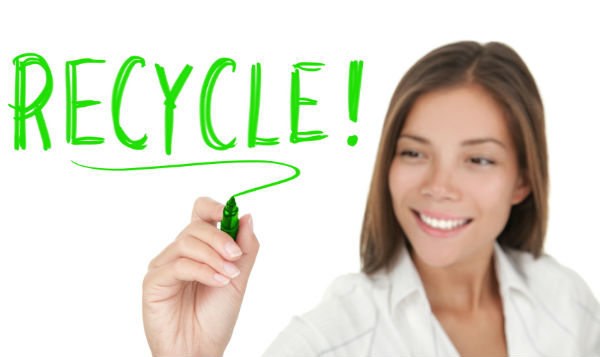It all begins with you. The recycling process is dependent on people taking the time to sort through trash, separate it and place it in the appropriate bin. On your recycling pick-up day, you have to take your recyclables to the curb. A truck comes by, and poof — it’s gone. Little do you know, an extensive process occurs that recreates your recyclable trash into that new fleece coat you just bought.
What happens after the truck collects all your recyclables? After pulling away from your home, the truck completes its round of collecting items from you neighborhood and returns to the recycling facility. There, each piece is separated into its classification, such as paper, plastic or aluminum. After this, each item is assessed to ensure that it is in fact a type of plastic or paper product that is recyclable. Once in its appropriate place, each different item finds a similar but unique path.
Paper is one of the easiest things to recycle. So easy you could do it at home (although you would end up with very bumpy paper as an end result). The paper is placed in a vat of hot water and detergent used to break the paper down and return it to its raw state, called pulp. Pulp is a mushy substance that makes the paper easy to stir, mix and turn. The detergent removes as much dye as possible to return the mix of paper to a neutral color. Once the paper pulp is an adequate consistency and color, it is poured and flattened on a conveyer belt, where it is dried. After drying, it is flattened again and cut to the same size and stored in rolls. It is shipped to various paper product manufacturers that turn the paper into the products you buy.
Glass is easy to recycle as well. Glass is separated by type. Some states will not break and melt certain types of glass bottles. Instead, they are cleaned and sanitized and returned to the manufacture. This saves energy, labor and water usage. All other glass is then crushed into pieces, referred to as cullet. The cullet continues on a conveyer belt that separates the glass from other foreign objects such as metal, labels and plastic objects. The crushed glass is blended with soda ash, limestone and silica sand and then placed in a furnace where it is melted. The melted glass is then reformed to create glass containers used for food storage and other items.
Aluminum comes in various forms, such as soda cans, tuna fish containers and TV dinner trays. Once picked up by the recycling truck, the products are cleaned and rinsed of any food or beverage residue. Many counties and cities sell the aluminum to local smelter yards or other metal buyers so they don’t have to deal with the recycling process. If the county or city does not sell the aluminum to a third party, it is typically melted down, purified and poured into molds in which the aluminum can be sold to manufactures in a pure form.
You are integral to the end of the recycling process as well. Choosing to purchase recycled toilet paper, napkins and other containers that say, “made from post-consumer material” helps complete the process. Purchasing recycled items helps to use less raw materials and fuel and saves forests. That is a win-win situation we can get used to.
Paper
Paper is one of the easiest things to recycle. So easy you could do it at home (although you would end up with very bumpy paper as an end result). The paper is placed in a vat of hot water and detergent used to break the paper down and return it to its raw state, called pulp. Pulp is a mushy substance that makes the paper easy to stir, mix and turn. The detergent removes as much dye as possible to return the mix of paper to a neutral color. Once the paper pulp is an adequate consistency and color, it is poured and flattened on a conveyer belt, where it is dried. After drying, it is flattened again and cut to the same size and stored in rolls. It is shipped to various paper product manufacturers that turn the paper into the products you buy.
Glass
Glass is easy to recycle as well. Glass is separated by type. Some states will not break and melt certain types of glass bottles. Instead, they are cleaned and sanitized and returned to the manufacture. This saves energy, labor and water usage. All other glass is then crushed into pieces, referred to as cullet. The cullet continues on a conveyer belt that separates the glass from other foreign objects such as metal, labels and plastic objects. The crushed glass is blended with soda ash, limestone and silica sand and then placed in a furnace where it is melted. The melted glass is then reformed to create glass containers used for food storage and other items.
